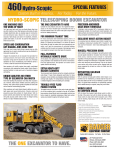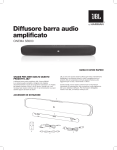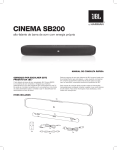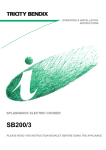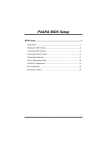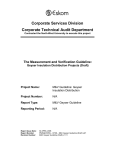Download Pecoware Thermostat TC170 User's Manual
Transcript
TC170 THERMOSTAT INSTALLATION ▲WARNING ! • READ THESE INSTRUCTIONS CAREFULLY BEFORE ATTEMPTING TO INSTALL, OPERATE OR SERVICE THIS THERMOSTAT. • Failure to observe safety information and comply with instructions could result in PERSONAL INJURY, DEATH AND/OR PROPERTY DAMAGE. • To avoid electrical shock or damage to equipment, disconnect power before installing or servicing and use only wiring with insulation rated for full thermostat operating voltage. • Before installing this control, the Voltage Selection Switch must be placed in the correct position. See instructions. • To avoid potential fire and/or explosion do not use in potentially flammable or explosive atmospheres. • Retain these instructions for future reference. This product, when installed, will be part of an engineered system whose specifications and performance characteristics are not designed or controlled by PECO. You must review your application and national and local codes to assure that your installation will be functional and safe. CAUTION • Use copper wire only, insulate or wire nut all unused leads. • Care should be used to avoid electrostatic discharge to the T170 thermostat. • This unit has configuration jumpers. You may need to reconfigure this thermostat for your application. See page 3. MOUNTING THE THERMOSTAT Thermostat mounts to a 4x4 box with a 2x4 mud ring. CAUTION All wiring connections must be made inside the electric box or the T170 maybe damaged. 2x4 Mud Ring Cover Locking Snaps (Both Sides) T170 Base 1. This thermostat is a 24 VAC only control. Leave the Voltage Selection Switch in the 24 VAC position for proper operation. Failure to select the correct voltage will result in thermostat malfunction or permanent thermostat damage. 2. Connect wires using the wiring diagram. Wire nut off all unused wires. All connections must be located in the outlet box. 3. Install the T170 base with the two furnished mounting screws to a standard 4 x 4 x 2-1/8” square device box with a 2” x 4” mud ring mounted horizontally. Tighten the screws evenly but do not over tighten. 4. To use a remote sensor on units with local sensing capability, remove jumper JP-1 to disable local sensing. Failure to remove JP-1 will cause improper operation of the thermostat with a remote probe installed. 5. Verify that the circuit board is firmly snapped into the cover and has not been dislodged during handling. 6. Install the cover assembly. Press firmly to engage the cover locking snaps. 7. Checkout: After wiring and installation is complete, energize the system. Set fan to ON. Set the system button to AUTO, or available selection. Using the UP arrow, adjust temperature above the ambient temperature to cycle heating stage(s) on. Using the DOWN arrow adjust the temperature below ambient temperature to cycle cooling stage(s) on. TYPICAL OPERATION System Button Operation OFF All thermostat outputs are off. AUTO The thermostat automatically selects heating or cooling mode depending upon the set point and room temperature. The appropriate HEAT or COOL icon are illuminated if demand exists. A 3°F dead-band is provided to prevent short cycling between heating and cooling modes. After changeover, the control point automatically shifts so that the control off point equals the set point temperature. COOL The thermostat operates as a cooling only thermostat. HEAT The thermostat operates as a heating only thermostat. Up/Down Arrow Button Operation Up/Down arrows increased or decreased temperature. Fan Button Operation In ON the fan output is continuous. In AUTO the output cycles with demand. Some models are available with Controlled Off and or Staged Fan. F/C Button Operation This button toggles from Fahrenheit to Celsius. Speed Button Operation Some models have a Speed button instead of a F/C button. Fan speed is determined by manual selection of HI or LO. Holding this button in for 5 seconds will toggle the displayed temperature from Fahrenheit to Celsius. T170 Cover Assembly © COPYRIGHT 2008 PECO, INC. ALL RIGHTS RESERVED. P/N 69289 3220-2083 REV 0 PAGE 1 • Occupancy Detection • Setback Operation • Door Switch Only Operation Occupancy Detection Install jumper JP3. The T170 can be used with the PECO S200 series occupancy detection equipment. The occupancy and door switch inputs are designed to connect to the SB200 slave sensor and SE200 door switch. The Occupancy sensor switch is open when there is occupancy and closed when unoccupied. The Door Switch is open when the door is open and closed when the door is closed. This system requires both an Occupancy Sensor and a Door Switch. Operation is as follows: FROM OCCUPIED MODE: 1. A door close signal initiates an occupancy status detection. 2. If occupancy is detected the T170 will maintain normal HVAC control. It then waits for a door open signal before determining occupancy again. 3. If no occupancy signal is detected within 2 minutes the T170 changes to unoccupied mode and controls at setback values. FROM UNOCCUPIED MODE: 1. The T170 continually monitors the room. 2. Any occupancy detection, including door open, will set the operation to occupied mode. In either mode, if the door is left open for more that 2 minutes the T170 will disable the HVAC system. A one-time ten minute override can be initiated by pressing any thermostat key pad. In an Occupied State the thermostat operates normally and looks for a door close. In the Unoccupied State the thermostat sets heating and cooling set points to setback values, as determined by factory or user settings. In this mode the fan is automatically set to cycle with demand. The T170 will continue to monitor the occupancy sensor and will go to occupied state anytime occupancy is detected. Setback Operation Remove jumper JP3. This is a low level switch input that is normally open. When closed the T170 Heating and Cooling setback limits are used as temperature control points. Fan operation in setback is cycled with demand. Pressing any button will override setback for 1 hour. Setback will override any user setting except if the control is turned to OFF. Units with a controlled off factory setting will override the OFF setting. Intelligent occupancy sensors like the SD200-001 and SD200-002 can be used with this input to set the HVAC system to control at setback limits. Door Switch Only Operation Install jumper JP3. A stand alone door switch can be connected to the T170 to disable the HVAC system if the door is left open for more that 2 minutes. A one-time ten minute override can be initiated by pressing any thermostat key pad. CONDENSATE OVERFLOW INTERRUPT The remote probe input can be used with a condensate overflow switch (CO), either in conjunction with a remote probe (normally closed CO switch) or with local sensing (normally open CO switch). When condensate switch activates, the T170 will display the service wrench and disable all outputs. Local Sensor Installation Remote Probe White/Yellow Normally Open Condensate Switch Circuit Common White/Violet Remote Probe Installation Remote Probe White/Yellow Normally Closed Condensate Switch Circuit Common White/Violet FAN OPERATION Your thermostat can be configured for up to two fan speeds. Fan staging follows the Heat and Cool Staging Separation. Heat and Cool staging can be user selected to different values. The FAN button is used to select FAN AUTO or ON. In the Auto position the fan cycles on with demand for heating or cooling. If ON is selected the fan will run continuously. FAN AUTO: Fan cycles on with demand FAN 2 ON (FAN 1 OFF) FAN ON: Fan runs continuously FAN 1 ON SETPOINT HVAC SETBACK SYSTEMS IF 2F 3F 4F Temperature Demand CONTROLLED OFF FACTORY CONFIGURATION A factory configuration may be provided to ensure minimum heat and cool requirements. With this configuration the heat and cool outputs are automatically cycled on at the heat and cool setback limits. Your thermostat may not have this feature. © COPYRIGHT 2008 PECO, INC. ALL RIGHTS RESERVED. P/N 69289 3220-2083 REV 0 PAGE 2 WIRING DIAGRAM OUTPUT RA TINGS INPUT VOLTAGE VOLTAGE PILOT DUTY 24 VAC 24 VAC 24 VA OUTPUT CONFIGURATION A table is provided on the inside of the base to document the function of various outputs. The function of configurable outputs should be filled in when the unit is installed. JP4 JUMPER SELECTION CAUTION: HIGH -VOL TAGE - REMOVE POWER BEFORE JP 4 JP 3 SWITCH 24 V 110277V JP4 JUMPER This jumper is temporarily installed at initial power up to reconfigure outputs 3 through 6. See Output Configuration. JP3 JUMPER JP3 JUMPER SELECTION SER VICING JP 1 JP1 JUMPER This jumper is shipped normally open. Placement of a jumper onto both pins allows for Occupancy Detection/ Door switch and Door Switch Only Operation. JP1 JUMPER SELECTION SWITCH POSITION This switc h i s p laced in the 24V positio n a t t he factor y. Thi s t hermostat will not functio n properly if located in 110-277V positio n CIRCUIT Removing this jumper allows the sensor to be located in a remote location. Accessory remote probe sensors are available in standard 60” lengths but can be extended to meet application requirements. BOARD In Cover © COPYRIGHT 2008 PECO, INC. ALL RIGHTS RESERVED. P/N 69289 3220-2083 REV 0 PAGE 3 SERVICE MENU Access to the Service Menu: 1. Hold the UP Arrow and DOWN Arrow buttons down for 5 seconds. 2. Current display icon will be turned off. 3. Service Menu numbers 1 through A are available. The SYSTEM button is used to scroll to the item to be changed. 4. The UP and DOWN buttons adjust the selection. HOLD BOTH FOR 5 SECONDS STEP THROUGH MENU NUMBERS AND ADJUSTS MENU FUNCTIONS AND SYSTEM SERVICE MENU FUNCTIONS 1 - Continuous Set Point Display At this feature either the F or C icon and the SETPOINT icon will be displayed. If the Continuous set point display is enabled the SETPOINT icon will flash. The Up or Down Arrow button will toggle between continuous display of set point and display of zone temperature. 2 - Fan Off Delay The FAN, OFF and digits are displayed. Digits represent the number of seconds the fan will stay on after the heating and cooling outputs are turned off. The Up or Down Arrow button can be depressed to increase / decrease value from 0-255 seconds. 3 - Range Limit LO The display reads the current minimum range setting, SETPOINT icon and LO icon. The Up or Down Arrow button can be depressed to increase / decrease value.. 4 - Range Limit High The display reads the current maximum temperature range adjustment, SETPOINT icon and HI icon. The Up or Down Arrow button can be depressed to increase / decrease value. 5 - Setback Heat The display reads current temperature range adjustment, the SETBACK icon and the HEAT icon. The Up or Down Arrow button can be depressed to increase / decrease value. 6 - Setback Cool The display reads current Cool setback value, the SETBACK icon and the COOL icon. The Up or Down Arrow button can be depressed to increase / decrease value. 7 - Zone Temperature Offset The display reads ones and tenths (0.0) with leading minus sign. The Up or Down Arrow button can be depressed to increase / decrease value +/- 9F. Increments are made in 1F and 0.5C. 8 - Keypad Lockout The ON and OFF icons are displayed. The enabled icon is flashing. OFF is the default. ON disables the keypad except for entry into the service menu. The Up or Down Arrow button can be depressed to select the mode. 9- Heat Stage Separation The AUX, HEAT and current separation icons are displayed. The value can be changed from 0-12F using the Up or Down buttons. A- Cool Stage Separation The AUX, COOL and current separation icons are displayed. The value can be changed from 0-12F using the Up or Down buttons. Note: These values are stored and recalled in the event of a power failure. OUTPUT CONFIGURATION MENU Four of the six TC170 relay outputs can be field configured for heat staging, cool staging, up to 2 fan speeds and a single outside air damper. Heat stage 1 and Fan low are permanently configured at the factory. The user is allowed to assign the remaining outputs. Your specific thermostat may come with a custom configuration for outputs 3-6. These can be reconfigured in the field. Output Configuration Assigning an output is accomplished as follows: 1. Remove Power from the TC170. 2. Install jumper JP4. To enter the Output Configuration Menu the unit must be powered up with jumper JP4 installed onto both pins. 3. Apply 24 VAC power to the control. On Power up the unit will display menu CO1. It will then display the icons associated with the menu item and the current output assignment. It will indicate a Zero if the menu item is not assigned. 4. Use the SYSTEM key to select the Menu Item you want to assign. See Menu Designations below. Menu Item CO1 CO2 CO3 CO4 CO5 CO6 Description HEAT STAGE 2 HEAT STAGE 3 COOL STAGE 1 COOL STAGE 2 FAN HIGH OUTSIDE AIR Icons Displayed HEAT and MED HEAT and HI COOL and LO COOL and HI FAN and HI AUX and FAN 5. Use the UP/DOWN arrows to select the output number to be assigned. See Output Designations below. Output NO. 1 2 3 4 5 6 Wire Color Blue Red White/Brown White/Red White/Orange Brown Configuration Heat Stage 1 Fan Low _______________ User Configured _______________ User Configured _______________ User Configured _______________ User Configured 6. Push/ Select the F/C key to assign the output to the menu item. The associated relay will energize when the output is assigned. Note: If you do not push the F/C key the output will not be assigned. When a function is assigned to an output, any previous functions that were assigned to that output will be disabled and become unassigned. 7. When configuration is complete turn power off and remove JP4. Unit is now ready for operation and checkout. NOTE: With JP4 installed no other control operation is available. © COPYRIGHT 2008 PECO, INC. ALL RIGHTS RESERVED. P/N 69289 3220-2083 REV 0 PAGE 4




